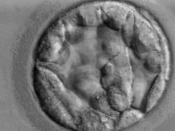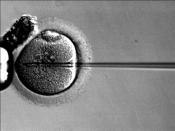In Vitro Fertilization
Introduction
In vitro fertilization was originally developed to enable women whose fallopian tubes are blocked to bear children because IVF procedures bypass the tubes. A woman's ovaries are stimulated with strong fertility drugs to produce multiple eggs, which are surgically removed. Her partner or donor then produces a sperm sample and the eggs and sperm are combined in a glass dish. If fertilization occurs, the resulting human embryos are inserted into the woman's uterus. If they implant in the uterine wall, a pregnancy will begin. The woman will give birth nine months later if she does not miscarry. (Morales, et al, p.2)
A single IVF attempt lasts about three weeks. It involves surgery, plus repeated ultrasonography and blood drawing. The fertility drugs that are essential to the procedure can produce very dangerous side effects. IVF is also emotionally stressful, since it may fail at any point in the procedure.
(Morales, et al, p.2)
The hormonal treatments used in IVF vary from clinic to clinic. Some use Lupron injections to suppress the woman's ovaries. After this initial procedure, hyperstimulation drugs are given. These injections are done both at home and at the clinic. These drugs produce great side effects for the mother. "During these injections, I did experience side effects. I was moody and sometimes I was nauseous and I was very stressed." (Mason, 2003, p.2)
History of Development
In vitro "in glass" fertilization began in Great Britain in the 1970's with Robert Edwards, a Ph.D. physiologist and Patrick Steptoe, a gynecologist. In the 1960's, Dr. Edwards experimented with human ovaries removed at surgery. In 1967, he was the first to fertilize a human egg outside of the body. At the same time, Steptoe was developing a technique called laparoscopy. The two men joined in 1971...


